9.3 Plant Growth & 9.4 Plant Reproduction
0.0(0)
0.0(0)
New
Card Sorting
1/53
Earn XP
Study Analytics
Name | Mastery | Learn | Test | Matching | Spaced |
|---|
No study sessions yet.
54 Terms
1
New cards
What are meristems?
tissues in a plant consisting of undifferentiated cells capable of indeterminate growth
2
New cards
How do meristems benefit plants?
allow plants to regrow structures or even form new plants (vegetative propagation)
3
New cards
Distinguish between the two types of meristematic tissue
apical meristems: occur at shoot and root tips, responsible for primary growth (plant lengthening), gives rise to new leaves/flowers
\
lateral meristems: occur at cambium, responsible for secondary growth (plant widening/thickening), responsible for the production of bark
\
lateral meristems: occur at cambium, responsible for secondary growth (plant widening/thickening), responsible for the production of bark
4
New cards
What cellular processes allows for apical growth?
a combination of cell enlargement and repeated cell division aka mitosis and cytokinesis
5
New cards
Describe how apical growth occurs
growth occurs in sections called nodes, the remaining meristem tissue forms an inactive axillary bud which can form new branching shoots with leaves and flowers
6
New cards
What is the main group of plant hormones involved in shoot and root growth? Where is it released?
auxins; released from the shoot apex
7
New cards
Describe how auxins promote apical growth
* production of auxins promotes growth in the shoot apex via elongation and division
* causes apical dominance meaning that it prevents growth in lateral buds, ensuring that a plant will use its energy to grow up towards the light
* as the distance between the terminal bud and axillary bud increases, the inhibition of the axillary bud diminishes
* different plant species have different levels of apical dominance
* causes apical dominance meaning that it prevents growth in lateral buds, ensuring that a plant will use its energy to grow up towards the light
* as the distance between the terminal bud and axillary bud increases, the inhibition of the axillary bud diminishes
* different plant species have different levels of apical dominance
8
New cards
Describe how plant pruning occurs
removing the terminal bud by cutting off the top of the plant allows for dormant lateral buds to develop, allowing for the production of wider plants
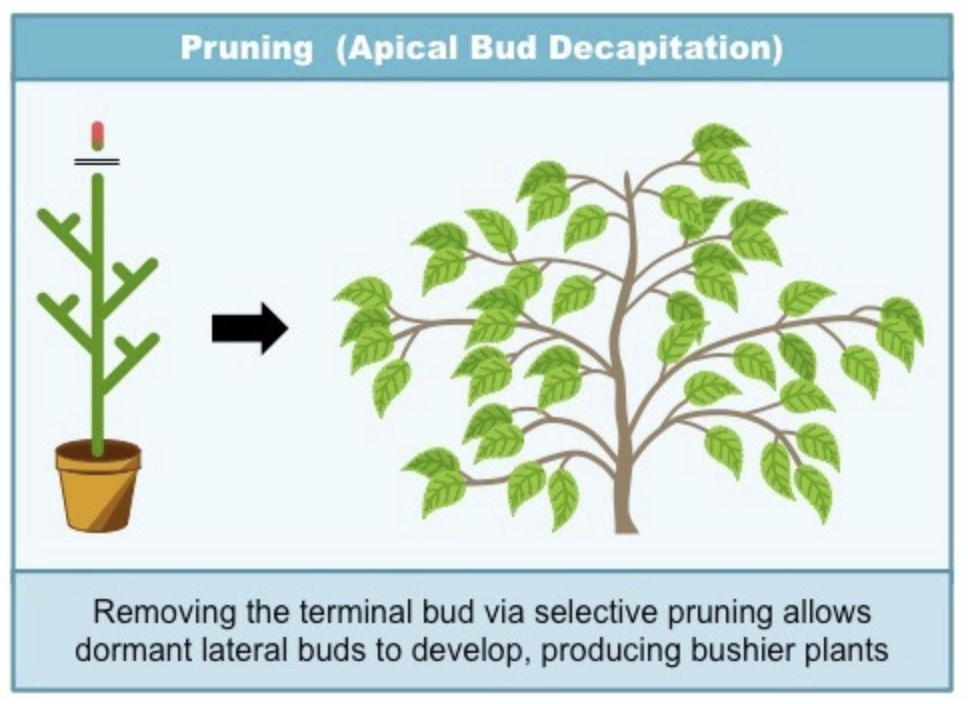
9
New cards
Describe how auxin efflux pumps can control the direction of plant growth
they can determine which regions of plant tissue have high auxin levels and hence set up a concentration gradient
10
New cards
Distinguish between the role of auxin in the roots vs the shoots of plants
* shoots: auxin stimulates cell elongation so high concentrations of auxin promote growth
* roots: auxin inhibits cell elongation so high concentrations of auxin limit growth
* roots: auxin inhibits cell elongation so high concentrations of auxin limit growth
11
New cards
Describe how auxin increases the flexibility of the cell wall to promote growth
* auxin activates a proton pump in the plasma membrane
* H+ ions are secreted into the cell wall
* pH decreases which causes cellulose fibers in the cell wall to loosen as bonds are broken
* auxin also upregulates the expression of expansins which increases the cell wall elasticity
* the influx of water causes the cell to increase in size as the cell wall is now more flexible
* H+ ions are secreted into the cell wall
* pH decreases which causes cellulose fibers in the cell wall to loosen as bonds are broken
* auxin also upregulates the expression of expansins which increases the cell wall elasticity
* the influx of water causes the cell to increase in size as the cell wall is now more flexible
12
New cards
What is phototropism
a growth movement in response to a unidirectional light source
13
New cards
What is geotropism
growth movement in response to gravitational forces
aka gravitropism
aka gravitropism
14
New cards
List 2 other tropisms besides phototropism and geotropism and describe them
hydrotropism: responding to a water gradient
thigmotropism: responding to a tactile stimulus
thigmotropism: responding to a tactile stimulus
15
New cards
Describe the change in auxin distribution to enable geotropism
* auxin accumulates on the lower side of the plant in response to gravity
* high auxin concentrations promote cell elongation in the shoot so the dark side elongates and the shoot grows upwards
* high auxin concentrations inhibit cell elongation in the roots so the lower side of the root becomes shorter causing the roots to turn downwards
* high auxin concentrations promote cell elongation in the shoot so the dark side elongates and the shoot grows upwards
* high auxin concentrations inhibit cell elongation in the roots so the lower side of the root becomes shorter causing the roots to turn downwards
16
New cards
Describe the change in auxin distribution to enable phototropism
* light receptors (phototropins) trigger the redistribution of auxin to the dark side of the plant
* the dark side of the shoot elongates and grows towards the light as high auxin concentrations in the shoot promotes growth
* the dark side of the root becomes shorter and the roots grow away from the light as high auxin concentrations in the root decreases growth
* the dark side of the shoot elongates and grows towards the light as high auxin concentrations in the shoot promotes growth
* the dark side of the root becomes shorter and the roots grow away from the light as high auxin concentrations in the root decreases growth
17
New cards
What is micropropagation
a technique used to produce large numbers of identical plants (clones) from a selected stock plant; plant tissues are cultured in the lab to reproduce asexually
18
New cards
What is vegetative propagation
when a plant cutting is used to reproduce asexually in the native environment
19
New cards
Describe the process of micropropagation
* specific plant tissue (usually from the undifferentiated shoot apex) is selected from a stock plant and sterilized
* the tissue sample is grown on a sterile nutrient agar gel
* the explant is treated with growth hormones like auxin to stimulate shoot and root development
* growing shoots can be continuously divided and separated to form new samples
* after development, the cloned plant can be moved to soil
* the tissue sample is grown on a sterile nutrient agar gel
* the explant is treated with growth hormones like auxin to stimulate shoot and root development
* growing shoots can be continuously divided and separated to form new samples
* after development, the cloned plant can be moved to soil
20
New cards
Describe how micropropagation can be used for rapid bulking
* desirable stock plants are cloned via micropropagation to conserve the fidelity of the selected characteristic
* more reliable than selective breeding because new plants are genetically identical to the stock plant
* also used to produce large quantities of plants created via genetic modification
* more reliable than selective breeding because new plants are genetically identical to the stock plant
* also used to produce large quantities of plants created via genetic modification
21
New cards
Describe how micropropagation is used to produce virus-free strains
* plant viruses have the potential to decimate crops
* can cripple economies and lead to famine
* viruses typically spread through infected plants via vascular tissue
* meristems don’t have vascular tissue
* propagating plants from non-infected meristems allows for the reproduction of virus-free plant strains
* can cripple economies and lead to famine
* viruses typically spread through infected plants via vascular tissue
* meristems don’t have vascular tissue
* propagating plants from non-infected meristems allows for the reproduction of virus-free plant strains
22
New cards
Describe how micropropagation can be used for the propagation of rare species
* used to increase rare or endangered plant species
* increases the numbers of species that are difficult to breed sexually
* can be used to increase numbers of plant species that are in commercial demand
* increases the numbers of species that are difficult to breed sexually
* can be used to increase numbers of plant species that are in commercial demand
23
New cards
List the methods of plant reproduction
* vegetative propagation (asexual reproduction from a plant cutting)
* spore formations
* pollen transfer (occurs in flowering plants)
* spore formations
* pollen transfer (occurs in flowering plants)
24
New cards
List the three phases in plant sexual reproduction
pollination, fertilization, and seed dispersal
25
New cards
Describe how pollination occurs
* pollen grains from an anther (male plant structure) to a stigma (female plant structure)
* many plants possess both male and female structures (monoecious); thus can potentially self-pollinate
* cross-pollination is preferable as it improves genetic diversity
* many plants possess both male and female structures (monoecious); thus can potentially self-pollinate
* cross-pollination is preferable as it improves genetic diversity
26
New cards
Describe how fertilization occurs
* fusion of a male gamete nuclei with a female gamete nuclei to form a zygote
* male gamete is stored in the pollen grain and the female gamete is found in the ovule
* male gamete is stored in the pollen grain and the female gamete is found in the ovule
27
New cards
Describe how seed dispersal aids in plant reproduction
* fertilization of gametes results in the formation of a seed which moves away from the parental plant
* seed dispersal reduces competition for resources between germinating plant and parental plant
* seed dispersal mechanisms: wind, water, fruits, animals
* seed dispersal reduces competition for resources between germinating plant and parental plant
* seed dispersal mechanisms: wind, water, fruits, animals
28
New cards
Describe the relationship between the pollinator and the flowering plant
* mutualistic relationship
* flowering plant gains a means of reproduction via the transference of pollen between plants
* animal gains a source of nutrition through nectar
* flowering plant gains a means of reproduction via the transference of pollen between plants
* animal gains a source of nutrition through nectar
29
New cards
List examples of pollinators
birds, bats, insects (bees, butterflies)
* some flowers are structured to optimize access for certain pollinators like tube shaped flowers for birds with long beaks
* some flowers are structured to optimize access for certain pollinators like tube shaped flowers for birds with long beaks
30
New cards
Describe the production of flowers
* develop from the shoot apex
* changes in gene expression trigger the enlargement of the shoot apical meristem
* tissue differentiates to form the different flower structures (sepals, petals, stamen, pistil)
* changes in gene expression trigger the enlargement of the shoot apical meristem
* tissue differentiates to form the different flower structures (sepals, petals, stamen, pistil)
31
New cards
What causes the activation of the gene responsible for flowering
* typically linked to the seasons
* typically come into bloom when a suitable pollinator is most abundant
* the most common trigger is day/night length (photoperiodism)
* typically come into bloom when a suitable pollinator is most abundant
* the most common trigger is day/night length (photoperiodism)
32
New cards
Distinguish between the terms monoecious and dioecious
monoecious: possesses both male and female structures
\
dioecious: may only possess one structure
\
dioecious: may only possess one structure
33
New cards
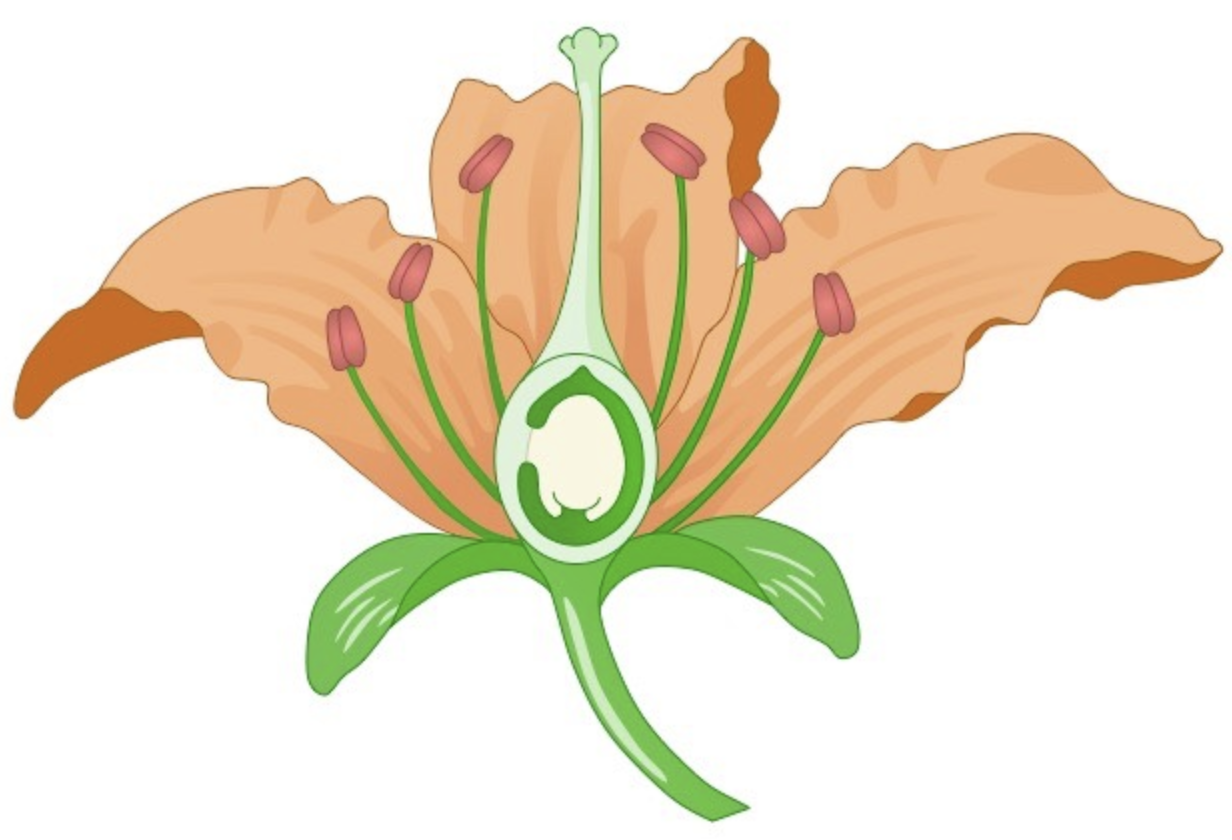
Label the parts of a flower
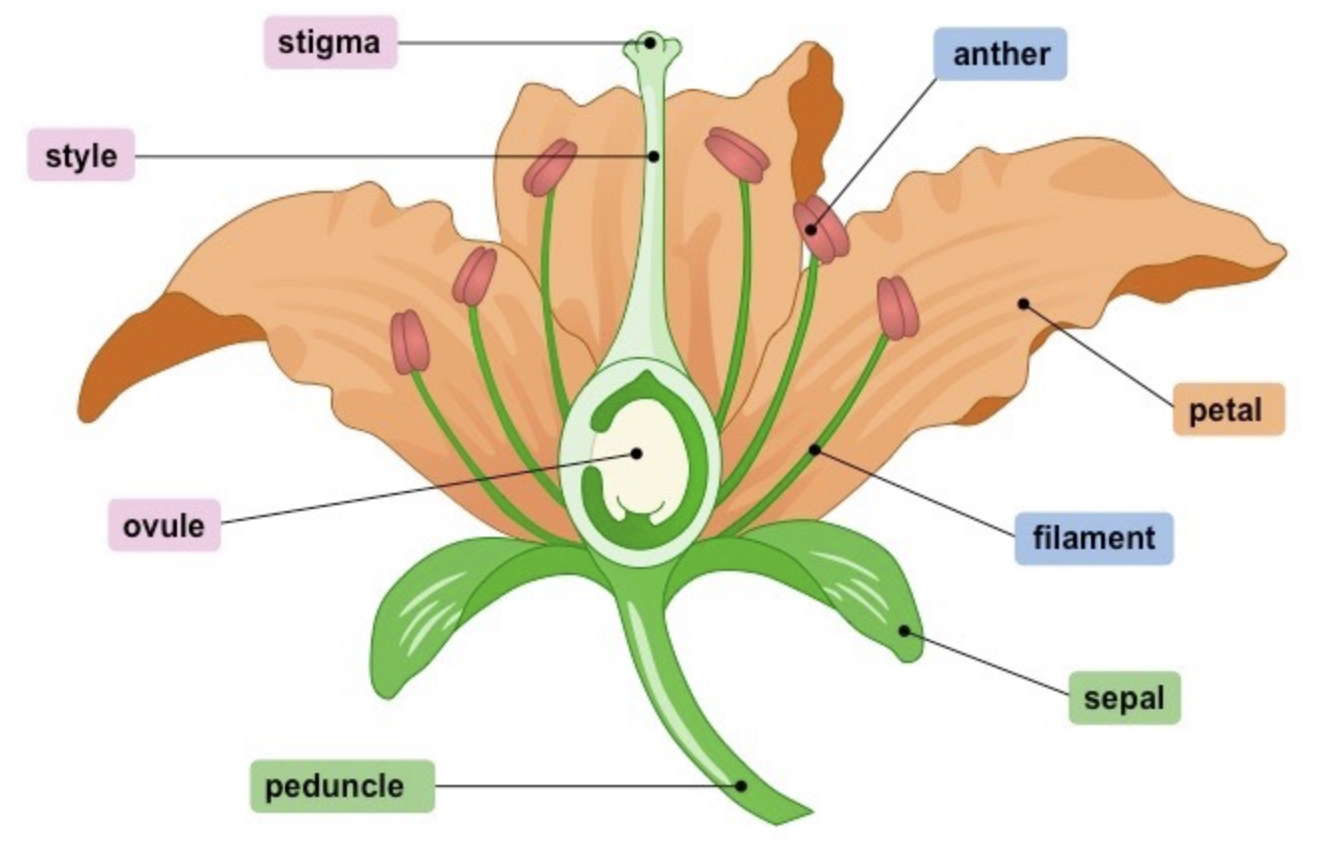
34
New cards
List the parts of a stamen
anther and filament
35
New cards
Describe the function of the anther
pollen producing organ of the flower, pollen is the male gamete of a flowering plant
36
New cards
Describe the function of the filament
slender stalk supporting the anther, makes the anther accessible to pollinators
37
New cards
List the parts of the pistil
stigma, style, ovule
38
New cards
Describe the structure & function of the stigma
sticky, receptive tip of the pistil that is responsible for catching the pollen
39
New cards
Describe the structure and function of the style
tube-shaped connection between the stigma and ovule (elevates the stigma to catch pollen)
40
New cards
Describe the function of the ovule
contains the female reproductive cells (after fertilization it develops into a seed)
41
New cards
List other flower reproductive structures excluded from the pistil and stamen and describe their function
* petals: brightly colored modified leaves that attract pollinators
* sepal: outer covering which protects the flower when in bud
* peduncle: stalk of the flower
* sepal: outer covering which protects the flower when in bud
* peduncle: stalk of the flower
42
New cards
Describe the function of phytocromes
leaf pigments that are used by the plant to detect periods of light and darkness
43
New cards
Describe what occurs when phytocromes detect light
* inactive form of phytochrome is converted into the active form when it absorbs red light
* active form of phytochrome is broken down into the inactive form when it absorbs far red light
* active form gradually reverts to the inactive form in the absence of light
* active form of phytochrome is broken down into the inactive form when it absorbs far red light
* active form gradually reverts to the inactive form in the absence of light
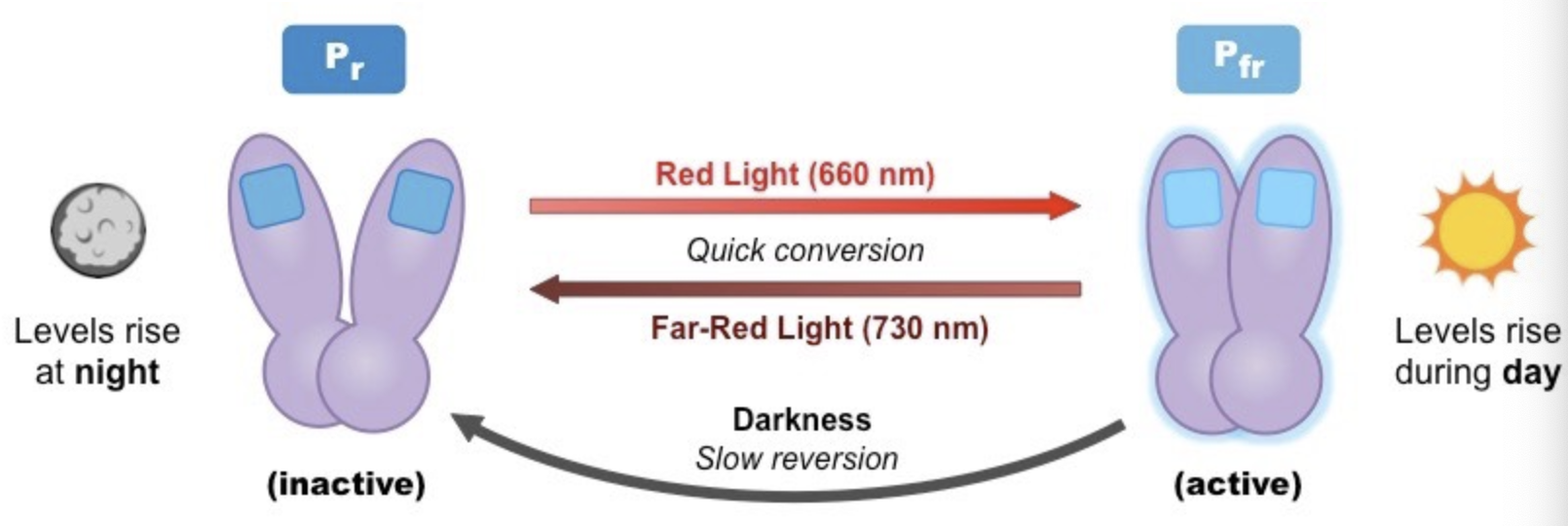
44
New cards
Distinguish between the flowering of short and long day plants
Short-day plants
* flower when the days are short meaning that they require the night period to exceed a critical length
* flowering occurs at at low levels of Pfr (the active form of phytochrome)
\
Long-day plants
* flower when the days are long meaning that the night period must be less than a critical length
* flowering occurs at high levels of Pfr
* flower when the days are short meaning that they require the night period to exceed a critical length
* flowering occurs at at low levels of Pfr (the active form of phytochrome)
\
Long-day plants
* flower when the days are long meaning that the night period must be less than a critical length
* flowering occurs at high levels of Pfr
45
New cards
Describe how horticulturalists can trigger long-day plants and provide an example
* typically don’t flower during winter and autumn months
* can trigger flowering by exposing the plant to a light source during the night
* ex) carnations
* can trigger flowering by exposing the plant to a light source during the night
* ex) carnations
46
New cards
Describe how horticulturalists can trigger long-night plants and provide an example
* typically don’t flower during the summer months
* can trigger by covering the plant with an opaque black cloth for around 12 hours each day
* ex) crysanthemums
* can trigger by covering the plant with an opaque black cloth for around 12 hours each day
* ex) crysanthemums
47
New cards
List the features of a seed
testa, micropyle, cotyledon, plumule, radicle
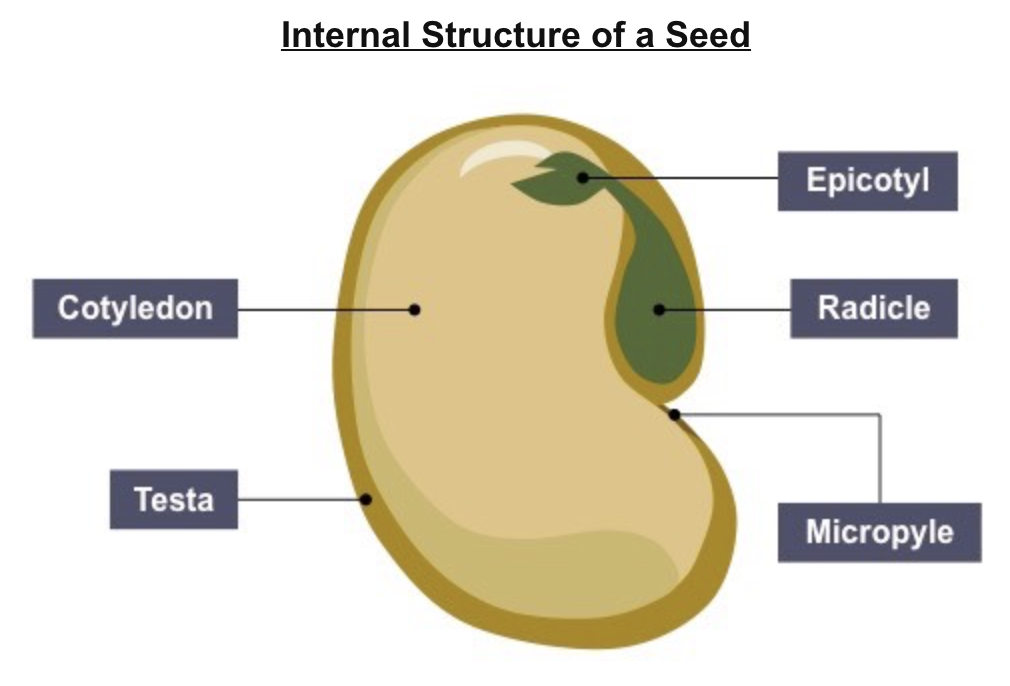
48
New cards
State the function of the testa of a seed
an outer seed coat that protects the embryonic plant
49
New cards
State the function of the micropyle of a seed
a small pore in the outer covering of the seed that allows for the passage of water
50
New cards
State the function of the cotyledon of a seed
contains the food stores for the seed and forms the embryonic leaves
51
New cards
State the function of the plumule of a seed
the embryonic shoot aka the epicotyl
52
New cards
State the function of the radicle of a seed
embryonic root
53
New cards
List the factors needed for germination of all seeds and the reasons for requirement
* oxygen: for aerobic respiration as the seed needs lots of ATP
* water: for metabolic activation as it triggers the synthesis of gibberellin
* temperature: for optimal function of enzymes
* pH: for optimal function of enzymes
* water: for metabolic activation as it triggers the synthesis of gibberellin
* temperature: for optimal function of enzymes
* pH: for optimal function of enzymes
54
New cards
List the specialized conditions for germination and the reasons for them
fire, freezing, digestion to erode the seed coat, washing to remove inhibitors, scarification to weaken the seed coat